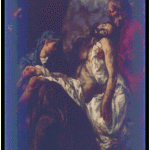Together with Mary let us turn to Jesus
We celebrate the feast of Our Lady of Sorrows on September 15th.
As the Mother of Our Redeemer, there existed an unbreakable bond between the Sacred Heart of Jesus and the Immaculate Heart of Mary.
While this undying union granted Mary the honor of sharing in the joys of her Son, it also produced intense sorrow when witnessing the sufferings of her Son.
The roots of this memorial can be traced back to the New Testament, but the memorial wasn’t celebrated as a universal feast of the Church until 1814. Prior to that, devotion to Our Lady of Sorrows first emerged during local celebrations around the Mediterranean in the eleventh century.
In 1233, seven devout men in Florence each had a vision from the Blessed Virgin Mary, inspiring them to form a religious community that would later be known as the Servites. Around the year 1240, these same men received another vision of the Mother of God, accompanied by angels. She informed them about their mission, provided them with their habits, presented their rule of life, and personally founded their order. In that apparition, they were instructed to spread devotion to the Seven Sorrows of Mary, which became one of their central missions. Through the efforts of the Servite order in the subsequent centuries, the liturgical celebration honoring Our Lady of Sorrows gradually expanded.
In the late thirteenth century, the traditional prayer, Stabat Mater (Standing Mother), was composed and quickly became well known. This prayer emphasizes the deep sorrow in Mary’s Heart as she stood before the Cross with tremendous strength and motherly compassion for her Son.
In 1809, against the Pope’s wishes, Napoleon decided to annex the Papal States to the French empire. After Pope Pius VII excommunicated Napoleon, the emperor arrested the pope and imprisoned him from 1809–1814. After Napoleon’s defeat in 1814, Pope Pius VII was released. In gratitude for the protection granted to him and to the entire Church through the Blessed Mother’s intercession, the pope extended the feast of Our Lady of Sorrows to the entire Latin Church.
Traditionally, the Memorial of Our Lady of Sorrows commemorates the seven sorrows in the Heart of Mary as recorded in Scripture (audio devotion below):
- The prophecy of Simeon (Luke 2:33–35)
- The flight into Egypt (Matthew 2:13–15)
- Loss of the Child Jesus for three days (Luke 2:41–50)
- Mary meets Jesus on His way to Calvary (Luke 23:27–31; John 19:17)
- Crucifixion and Death of Jesus (John 19:25–30)
- The body of Jesus being taken from the Cross (Luke 23:50–54; John 19:31–37)
- The burial of Jesus (Isaiah 53:8–9; Luke 23:50–56; John 19:38–42; Mark 15:40–47)
The Blessed Virgin Mary first learned about the sword that would pierce her heart while presenting the Child Jesus in the Temple with Saint Joseph on the eighth day for His naming and circumcision. “Simeon blessed them and said to Mary His mother, ‘Behold, this child is destined for the fall and rise of many in Israel, and to be a sign that will be contradicted (and you yourself a sword will pierce) so that the thoughts of many hearts may be revealed’” (Luke 2:34–35). Simeon’s prophecy was the first piercing of her heart because it is the first scriptural record of Mary knowing that her Son would suffer. The next six traditional sorrows paint the developing picture of the fulfillment of that prophecy.
As we honor the Blessed Mother’s Sorrowful Heart, it’s important to understand that a “sorrowful” heart is not the same as a “sad” heart. Theologically speaking, sadness results from a form of self-pity, or an unhealthy attachment to something that was lost. Sorrow, on the other hand, is one of the Beatitudes, and therefore one of the holiest qualities we can possess. “Blessed are they who mourn, for they will be comforted” (Matthew 5:4). To “mourn” is to have a sorrowful heart. In this context of the Beatitudes, a heart that mourns is a heart that loves. Mourning, or holy sorrow, results from a heart that witnesses sin and grieves over it. In the Blessed Mother’s case, she witnessed the brutal treatment of her Son, His rejection, suffering, and death. She did not despair as she witnessed this. She did not become angry. She did not succumb to confusion and frustration. She did not withdraw into herself in self-pity. Instead, she reacted with the empathetic love that flows from the holiest of hearts. She felt holy sorrow—not so much because she felt bad for her Son, but because she grieved over the sins that inflicted that suffering, and longed to see those sins redeemed.
As we commemorate the Sorrowful Heart of Mary today, it is an important opportunity to reflect upon your own sorrow. Is your sorrow self-centered, dwelling over the wounds you feel? Or is it selfless—meaning, does your sorrow extend to others, grieving in a holy way over the sins you witness? When our sorrow is holy, we are filled with compassion and spiritual empathy. The word “compassion” means “to suffer with.” The Blessed Mother, united with her Son’s Sacred Heart, suffered with her sinful children as she watched their sins crucify her Son. She harbored no hate as she witnessed those sins, only an indescribable longing to see the grace of her Son pour forth upon those who had rejected Him and sinned against Him.
The Seven Sorrows Of The Blessed Virgin Mary
Introduction to the Devotion
The purpose of the Devotion of the Seven Sorrows is to promote union with the sufferings of Christ through union with the special suffering that Our Lady endured because she was the Mother of God. By uniting ourselves with both the Passion of Christ and His holy Mother, we enter into Jesus’ Heart and honor Him greatly; He is more honored because we have so honored His Mother.
The Seven Dolors are taken from Scripture events and the devotion has a long history, although it was not officially promulgated by the Church until the early nineteenth century. Before Pope Pius VII’s formal approval, the Servite Order had permission in 1668 to celebrate the Feast of the Seven Dolors because the Order was instrumental in popularizing the Seven Sorrows Devotion.
In the Middle Ages, Catholic theology concentrated mostly on Christ’s Passion; at the side of the Man of Sorrows, however, the faithful always contemplated the Queen of Martyrs. Devotion to the Crucified Christ and to Our Lady of sorrows grew side by side. On Calvary there were in a sense two altars, one in the Body of Jesus, and the other in the Immaculate Heart. Christ immolated His flesh, Mary, her heart, her own soul. On September 15, the day following the ancient feast of the Holy Cross, the Church commemorates the compassion of Mary; but it is fitting during the year, especially during Lent, to honor the Sorrows of Mary.
Mary is not mentioned in the Gospel accounts of Christ’s Transfiguration, His entry into Jerusalem, but she is recorded as being present at Calvary. She understood what the Will of God was and was faithful, co-operating with her Son as Co-redemptrix. She had prepared the victim for sacrifice and now she offered Him on the altar of Calvary.
The Gospel, John 19:25, says: “Near the Cross of Jesus stood His mother, his mother’s sister, Mary, the wife of Cleopas, and Mary Magdalene.” At Christ’s bequest, Mary was proclaimed the universal Mother of mankind from the Cross.
Mary had three loves in her Immaculate Heart: God, her Son, and souls. She so loved the world that she gave her only Son. As St. Bernard said, “The sword would not have reached Jesus if it had not pierced Mary’s heart.” Mary loved souls and on Calvary, after suffering such cruel torments she merited being the mother of all mankind.
Mary is the Apostle because she is Co-redemptrix: Behold Mary on Calvary, she suffers and prays; she stands, as one offering sacrifice.
St. Ambrose said, “I read that she stood, but I do not read that she wept.” When Mary gave us her Son, she gave us everything. Therefore it can very well be said: “Behold this heart which has so greatly loved all people that it has spared nothing for them.”
Sorrow 1
The Presentation in the Temple (Luke 2:34-35)
Sorrow as sharp as a sword shall pierce Mary’s heart because of her Child. Mary is in the Temple, having come with Joseph to present the Child to God. They meet Simeon, the holy man, and Anna, the prophetess. Simeon takes the Baby in his arms, saying he will now die in peace because he has seen Christ, then he foretells the sorrow to come.
FIRST PRAYER OF THE CHAPLET:
The Seven Dolores of The Blessed Virgin Mary
V: O God, come to my assistance;
R: O Lord, make haste to help me
V: Glory be to the Father, and to the Son, and to the Holy Spirit.
R: As it was in the beginning, is now, and ever shall be, world without end. Amen.
1. I grieve for you, O Mary, most sorrowful, in the affliction of your tender heart at the prophecy of the holy and aged Simeon. Dear Mother, by your heart so afflicted, obtain for me the virtue of humility and the gift of the holy fear of God.
Hail Mary, full of grace, the Lord is with thee. Blessed art thou among women and blessed is the fruit of of thy womb, Jesus. Holy Mary, Mother of God, pray for us sinners, now, and at the hour of our death. Amen.
Sorrow 2
The Flight into Egypt (Matthew 2:13-21)
Soon the sword of sorrow strikes. Herod the King seeks to kill the Child. Warned in sleep by an angel, Joseph takes Jesus and His Mother Mary, setting out for Egypt, where they lived in obscurity and poverty until it was safe to return to Nazareth.
THE SECOND PRAYER OF THE CHAPLET:
The Seven Dolores of The Blessed Virgin Mary
V: O God, come to my assistance;
R: O Lord, make haste to help me
V: Glory be to the Father, and to the Son, and to the Holy Spirit.
R: As it was in the beginning, is now, and ever shall be, world without end. Amen.
2. I grieve for you, O Mary most sorrowful, in the anguish of your most affectionate heart during the flight into Egypt and your sojourn there.
Dear Mother, by your heart so troubled, obtain for me the virtue of generosity, especially toward the poor, and the gift of piety.
Hail Mary, full of grace, the Lord is with thee. Blessed art thou among women and blessed is the fruit of of thy womb, Jesus. Holy Mary, Mother of God, pray for us sinners, now, and at the hour of our death. Amen.
Sorrow 3
Loss of Jesus For Three Days (Luke 2:41-50)
When Jesus is twelve, He is taken to Jerusalem for the Feast of Passover. On the return journey Joseph and Mary find at the end of the first day that Jesus is not with them. Racked with anxiety, they search for Him. Nobody in the streets, not even the beggars, can tell them where He is. Not till the third day do they find Him, in the Temple.
THE THIRD PRAYER OF THE CHAPLET:
The Seven Dolores of The Blessed Virgin Mary
V: O God, come to my assistance;
R: O Lord, make haste to help me
V: Glory be to the Father, and to the Son, and to the Holy Spirit.
R: As it was in the beginning, is now, and ever shall be, world without end. Amen.
3. I grieve for you, O Mary most sorrowful, in those anxieties which tried your troubled heart at the lost of your dear Jesus. Dear Mother, by your heart so full of anguish, obtain for me the virtue of chastity and the gift of knowledge.
Hail Mary, full of grace, the Lord is with thee. Blessed art thou among women and blessed is the fruit of of thy womb, Jesus. Holy Mary, Mother of God, pray for us sinners, now, and at the hour of our death. Amen.
Sorrow 4
The Way to Calvary (John 19:17)
Mary has known fear and sorrow, but none so great as seeing her beloved Son stumbling under the weight of the Cross. She hears the jeering shouts from the crowd and has no power to help Him. Pity and love are in her eyes as she gazes at His blood-stained face. To many around her He is no better than a criminal, and her heart is breaking as she follows Him to Calvary or Golgotha.
THE FOURTH PRAYER OF THE CHAPLET:
The Seven Dolores of The Blessed Virgin Mary
V: O God, come to my assistance;
R: O Lord, make haste to help me
V: Glory be to the Father, and to the Son, and to the Holy Spirit.
R: As it was in the beginning, is now, and ever shall be, world without end. Amen.
4. I grieve for you, O Mary most sorrowful, in the consternation of your heart at meeting Jesus as He carried His cross. Dear Mother, by your heart so troubled, obtain for me the virtue of patience and the gift of fortitude.
Hail Mary, full of grace, the Lord is with thee. Blessed art thou among women and blessed is the fruit of of thy womb, Jesus. Holy Mary, Mother of God, pray for us sinners, now, and at the hour of our death. Amen.
Sorrow 5
The Crucifixion (John 19:18-30)
With John, Mary stands at the foot of the Cross. “A sword shall pierce thy soul,” Simeon told her. Truly her heart is pierced with sorrow. Her beloved Son is dying and she shares in His suffering. She does not ask God to take away this agony. She is His Mother, so close to Him that His pain is hers, too. And now He speaks from the Cross: “Woman, behold thy son.” Jesus give His Mother to John, and to us. For all eternity she is our Mother.
THE FIFTH PRAYER OF THE CHAPLET:
The Seven Dolors of The Blessed Virgin Mary
V: O God, come to my assistance;
R: O Lord, make haste to help me
V: Glory be to the Father, and to the Son, and to the Holy Spirit.
R: As it was in the beginning, is now, and ever shall be, world without end. Amen.
5. I grieve for you, O Mary most sorrowful, in the martyrdom which your generous heart endured in standing near Jesus in His agony. Dear Mother, by your afflicted heart, obtain for me the virtue of temperance and the gift of counsel.
Hail Mary, full of grace, the Lord is with thee. Blessed art thou among women and blessed is the fruit of of thy womb, Jesus. Holy Mary, Mother of God, pray for us sinners, now, and at the hour of our death. Amen.
Sorrow 6
The Descent from the Cross (John 19:39-40)
It is over. Dark clouds have appeared in the sky and upon the world. Jesus is dead. Joseph of Arimathea and Nicodemus take down the Body from the Cross. and Mary receives It in her arms. She is filled with a sadness that no human heart has known. This is her Son. Once she had cradled Him in her arms. listened to His voice, watched Him working at the carpenter’s bench. Now He is dead. She does not weep, her grief is too great for tears.
THE SIXTH PRAYER OF THE CHAPLET:
The Seven Dolores of The Blessed Virgin Mary
V: O God, come to my assistance;
R: O Lord, make haste to help me
V: Glory be to the Father, and to the Son, and to the Holy Spirit.
R: As it was in the beginning, is now, and ever shall be, world without end. Amen.
6. I grieve for you, O Mary most sorrowful, in the wounding of your compassionate heart, when the side of Jesus was struck by the lance before His Body was removed from the cross. Dear Mother, by your heart thus transfixed, obtain for me the virtue of fraternal charity and the gift of
understanding.
Hail Mary, full of grace, the Lord is with thee. Blessed art thou among women and blessed is the fruit of of thy womb, Jesus. Holy Mary, Mother of God, pray for us sinners, now, and at the hour of our death. Amen.
Sorrow 7
The Burial of Jesus (John 19:39-42)
Hastily the Body is wrapped in a clean linen cloth. Nicodemus has brought myrrh and aloes, and the Body is bound in the Shroud with them. nearby is a new tomb, belonging to Joseph of Arimathea, and there they lay Jesus. Mary and John and the holy women follow them and watch as the great stone to the sepulchre is rolled. it is the end.
THE SEVENTH PRAYER OF THE CHAPLET:
The Seven Dolores of The Blessed Virgin Mary
V: O God, come to my assistance;
R: O Lord, make haste to help me
V: Glory be to the Father, and to the Son, and to the Holy Spirit.
R: As it was in the beginning, is now, and ever shall be, world without end. Amen.
7. I grieve for you, O Mary most sorrowful, for the pangs that wrenched your most loving heart at the burial of Jesus. Dear Mother, by your heart sunk in the bitterness of desolation, obtain for me the virtue of diligence and the gift of wisdom.
Hail Mary, full of grace, the Lord is with thee. Blessed art thou among women and blessed is the fruit of of thy womb, Jesus. Holy Mary, Mother of God, pray for us sinners, now, and at the hour of our death. Amen.
PRAYER OF ST. ALPHONSUS DE LIGUORI
O afflicted Virgin, O soul great in virtues, as in sorrows, both the one and the other spring from that great fire burning in thyr heart for God, the only love of thy heart!
Mother, have pity on me, who has not loved God, and who has so greatly offended Him. Thy sorrows, it is true, assure me of pardon, but that is not sufficient. I wish to love God. Who could obtain for me that grace if not thee, who are the Mother of holy love! O Mary, Thou consolest everyone; favor me also, with thy consolations. Amen.
The Seven Graces of this Devotion
1. I will grant peace to their families.
2.They will be enlightened about the Divine mysteries.
3. I will console them in their pains and I will accompany them in their work.
4. I will give them as much as they ask for as long as it does not oppose the adorable will of my Divine Son or the sanctification of their souls.
5. I will defend them in their spiritual battles with the infernal enemy and I will protect them at every instant of their lives.
6. I will visibly help them at the moment of their death, they will see the face of their Mother.
7. I have obtained this Grace from my Divine Son, that those who propagate this devotion to my tears and dolors, will be taken directly from this earthly life to eternal happiness since all their sins will be forgiven and my Son and I will be their eternal consolation and joy.
1. To realize the value of a soul, worth the supreme Sacrifice on Calvary.
2. To work for souls, by evangelization, duty to life’s duties, and
prayer for sinners.
3. To pray always, in a life of union with God; whoever has a heart similar to Jesus’ and Mary’s hearts, will work for the salvation of souls.
When we commit sin we bring sorrow to Our Lady, for she is, indeed
our very Mother, our spiritual Mother, and she watches over
us as she watched over her Baby, nearly two thousand years ago.
It is the desire of Jesus that we should think of His Passion, to offer Him
our devotion and to renew our sorrow for sin. It is also His desire,
as the Church makes clear to us, that we should think of the
compassion of Mary in His Passion.
